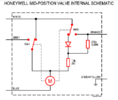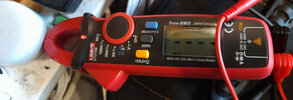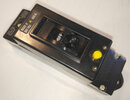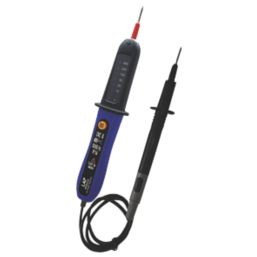- Joined
- 27 Jan 2008
- Messages
- 23,668
- Reaction score
- 2,667
- Location
- Llanfair Caereinion, Nr Welshpool
- Country

Pure interest, as I don't have solar panels or an EV charging point, but I read on another forum "all info refers to using a 1741+ that has a specific 'EV' setting for going the 6mA DC test." sure it should say doing.
I assume it injects 6 mA DC to see if it auto disconnects? As why only EV charging points have a 6 mA DC or a loss of PEN detection I don't know, as any diode can cause DC, and any item outside of the equipotential zone can cause danger with loss of PEN, it is not restricted to EV charging points.
I tried to measure DC with my own house, and found the zeroing of the clamp on means to measure 6 mA is not easy, with the AC scale measuring the leakage in mA to ensure under 9 mA not a problem, but DC seems a little hit and miss.
So putting a 6 mA DC load does seem a reasonable method, I look at this and the three port valve has been around for some time, no idea how much goes through the motor, but these must cause some DC on the supply, but not seen any directives to the effect any property with Y plan should fail an EICR with type AC RCD's.
and the three port valve has been around for some time, no idea how much goes through the motor, but these must cause some DC on the supply, but not seen any directives to the effect any property with Y plan should fail an EICR with type AC RCD's.
I personally take the attitude the RCD is secondary protection, and with 14 RCBO's it is very unlikely a fault will stop the RCD bit working at the same time as a earth fault happens. The RCBO's all said type B on the boxes, it was only after they were fitted found they were type AC.
I found this thread started by @RF Lighting back in 2016 talking about testing for mA leakage, and back in 2004 I know I had a problem with tripping RCD which seemed to be cured by replacing it, although the RCD tester showed both old and new to be well within spec.
Back then never even considered DC. In 2010 @bernardgreen did some tests here with interesting results.
So it seems nothing new, but we still test the RCD with nothing connected, and until last year I could not measure DC mA or and AC mA under 10 mA, and I am sure many are the same, the insulation tester uses DC so that not really any help.
When I started using a loop impedance tester on a regular basis I found I got a feel for likely results, so although it may have passed, I would question it when unexpected results were found, but today I don't do enough testing to get a feel with AC and DC milliamps with regard to RCD's.
I assume it injects 6 mA DC to see if it auto disconnects? As why only EV charging points have a 6 mA DC or a loss of PEN detection I don't know, as any diode can cause DC, and any item outside of the equipotential zone can cause danger with loss of PEN, it is not restricted to EV charging points.
I tried to measure DC with my own house, and found the zeroing of the clamp on means to measure 6 mA is not easy, with the AC scale measuring the leakage in mA to ensure under 9 mA not a problem, but DC seems a little hit and miss.
So putting a 6 mA DC load does seem a reasonable method, I look at this
 and the three port valve has been around for some time, no idea how much goes through the motor, but these must cause some DC on the supply, but not seen any directives to the effect any property with Y plan should fail an EICR with type AC RCD's.
and the three port valve has been around for some time, no idea how much goes through the motor, but these must cause some DC on the supply, but not seen any directives to the effect any property with Y plan should fail an EICR with type AC RCD's.I personally take the attitude the RCD is secondary protection, and with 14 RCBO's it is very unlikely a fault will stop the RCD bit working at the same time as a earth fault happens. The RCBO's all said type B on the boxes, it was only after they were fitted found they were type AC.
I found this thread started by @RF Lighting back in 2016 talking about testing for mA leakage, and back in 2004 I know I had a problem with tripping RCD which seemed to be cured by replacing it, although the RCD tester showed both old and new to be well within spec.
Back then never even considered DC. In 2010 @bernardgreen did some tests here with interesting results.
So it seems nothing new, but we still test the RCD with nothing connected, and until last year I could not measure DC mA or and AC mA under 10 mA, and I am sure many are the same, the insulation tester uses DC so that not really any help.
When I started using a loop impedance tester on a regular basis I found I got a feel for likely results, so although it may have passed, I would question it when unexpected results were found, but today I don't do enough testing to get a feel with AC and DC milliamps with regard to RCD's.




